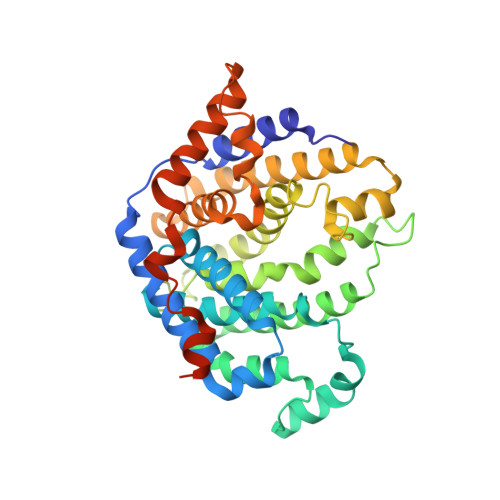Molecular Recognition of the Substrate Diphosphate Group Governs Product Diversity in Trichodiene Synthase Mutants.
Vedula, L.S., Rynkiewicz, M.J., Pyun, H.J., Coates, R.M., Cane, D.E., Christianson, D.W.(2005) Biochemistry 44: 6153-6163
- PubMed: 15835903
- DOI: https://doi.org/10.1021/bi050059o
- Primary Citation of Related Structures:
1YJ4, 1YYQ, 1YYR, 1YYS, 1YYT, 1YYU - PubMed Abstract:
The X-ray crystal structures of Y305F trichodiene synthase and its complex with coproduct inorganic pyrophosphate (PP(i)) and of Y305F and D100E trichodiene synthases in ternary complexes with PP(i) and aza analogues of the bisabolyl carbocation intermediate are reported. The Y305F substitution in the basic D(302)RRYR motif does not cause large changes in the overall structure in comparison with the wild-type enzyme in either the uncomplexed enzyme or its complex with PP(i). However, the loss of the Y305F-PP(i) hydrogen bond appears to be compensated by a very slight shift in the position of the side chain of R304. The putative bisabolyl carbocation mimic, R-azabisabolene, binds in a conformation and orientation that does not appear to mimic that of the actual carbocation intermediate, suggesting that the avid inhibition by R- and S-azabisabolenes arises more from favorable electrostatic interactions with PP(i) rather than any special resemblance to a reaction intermediate. Greater enclosed active-site volumes result from the Y305F and D100E mutations that appear to confer greater variability in ligand-binding conformations and orientations, which results in the formation of aberrant cyclization products. Because the binding conformations and orientations of R-azabisabolene to Y305F and D100E trichodiene synthases do not correspond to binding conformations required for product formation and because the binding conformations and orientations of diverse substrate and carbocation analogues to other cyclases such as 5-epi-aristolochene synthase and bornyl diphosphate synthase generally do not correspond to catalytically productive complexes, we conclude that the formation of transient carbocation intermediates in terpene cyclization reactions is generally under kinetic rather than thermodynamic control.
Organizational Affiliation:
Roy and Diana Vagelos Laboratories, Department of Chemistry, University of Pennsylvania, Philadelphia, Pennsylvania 19104-6323, USA.

















